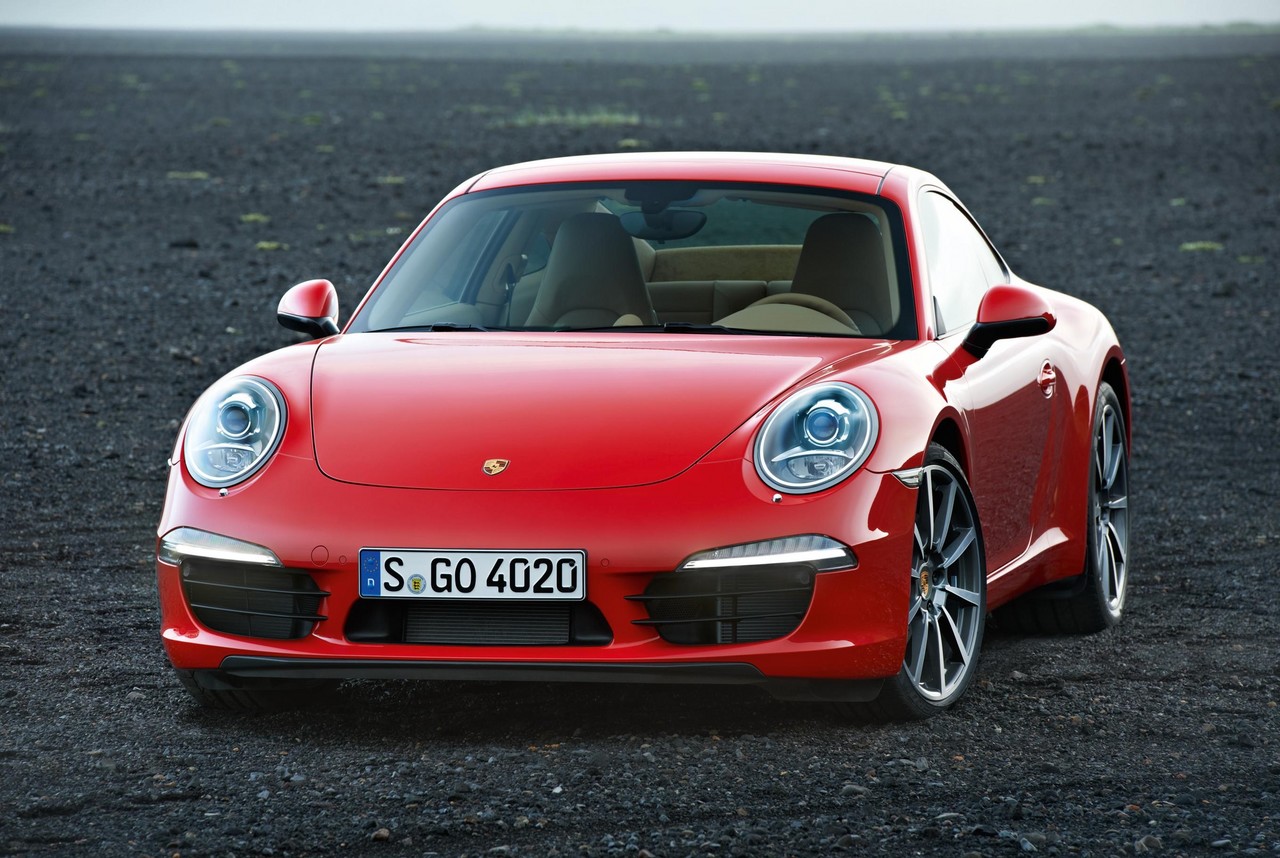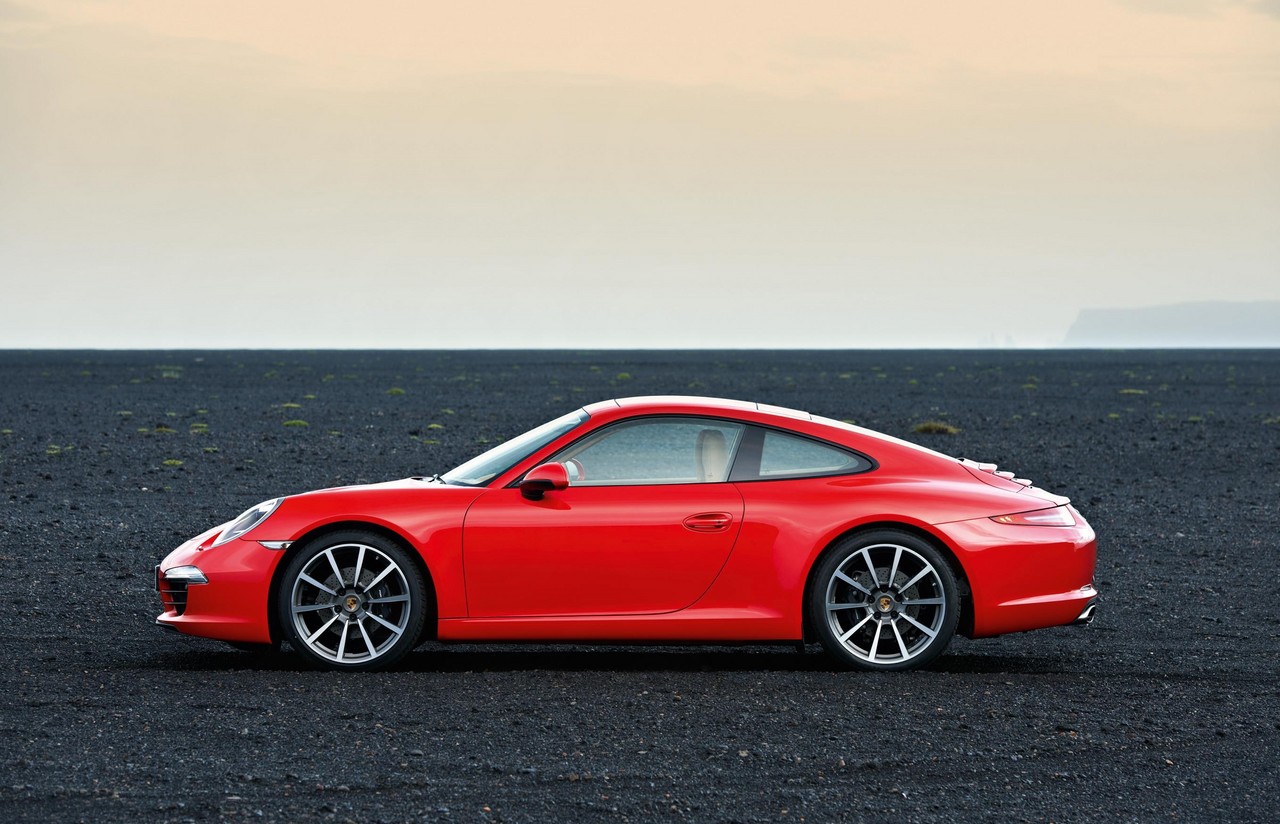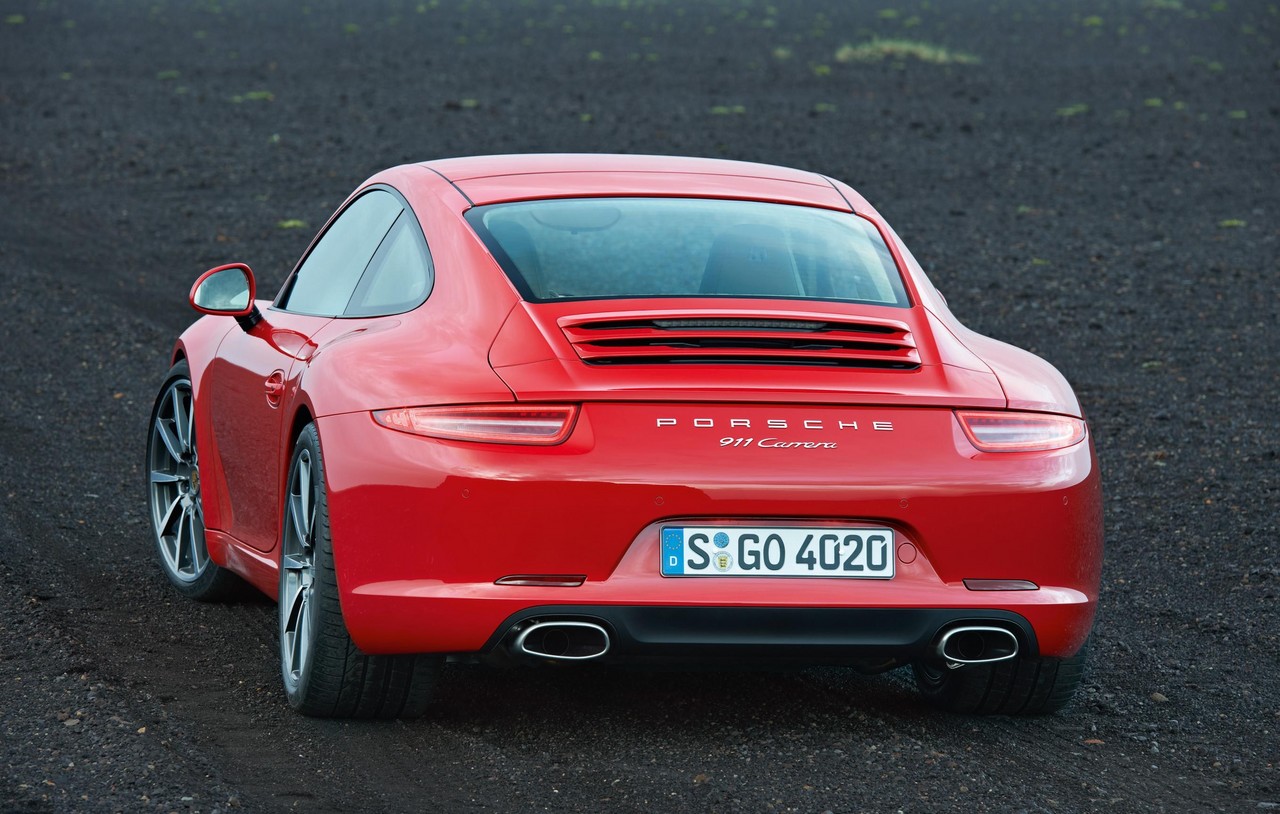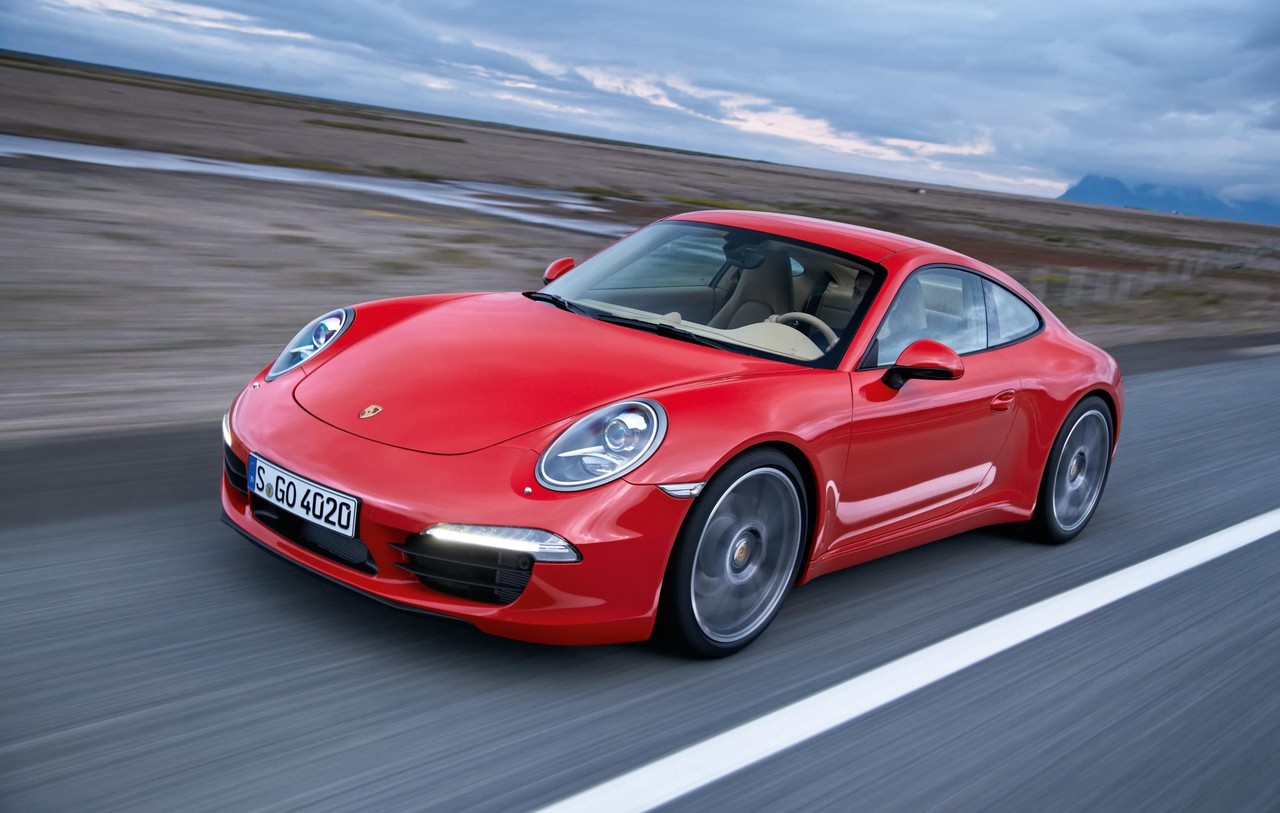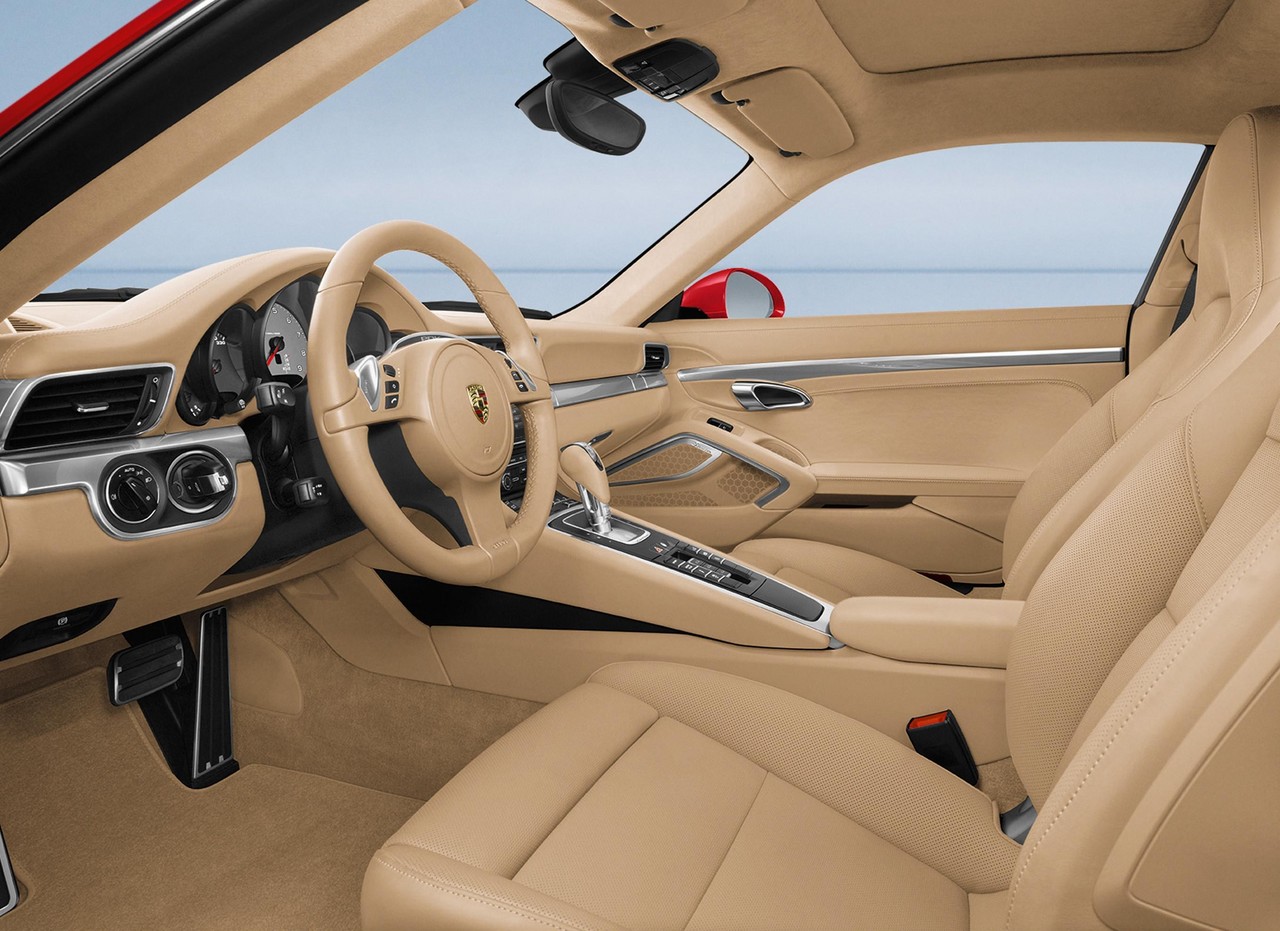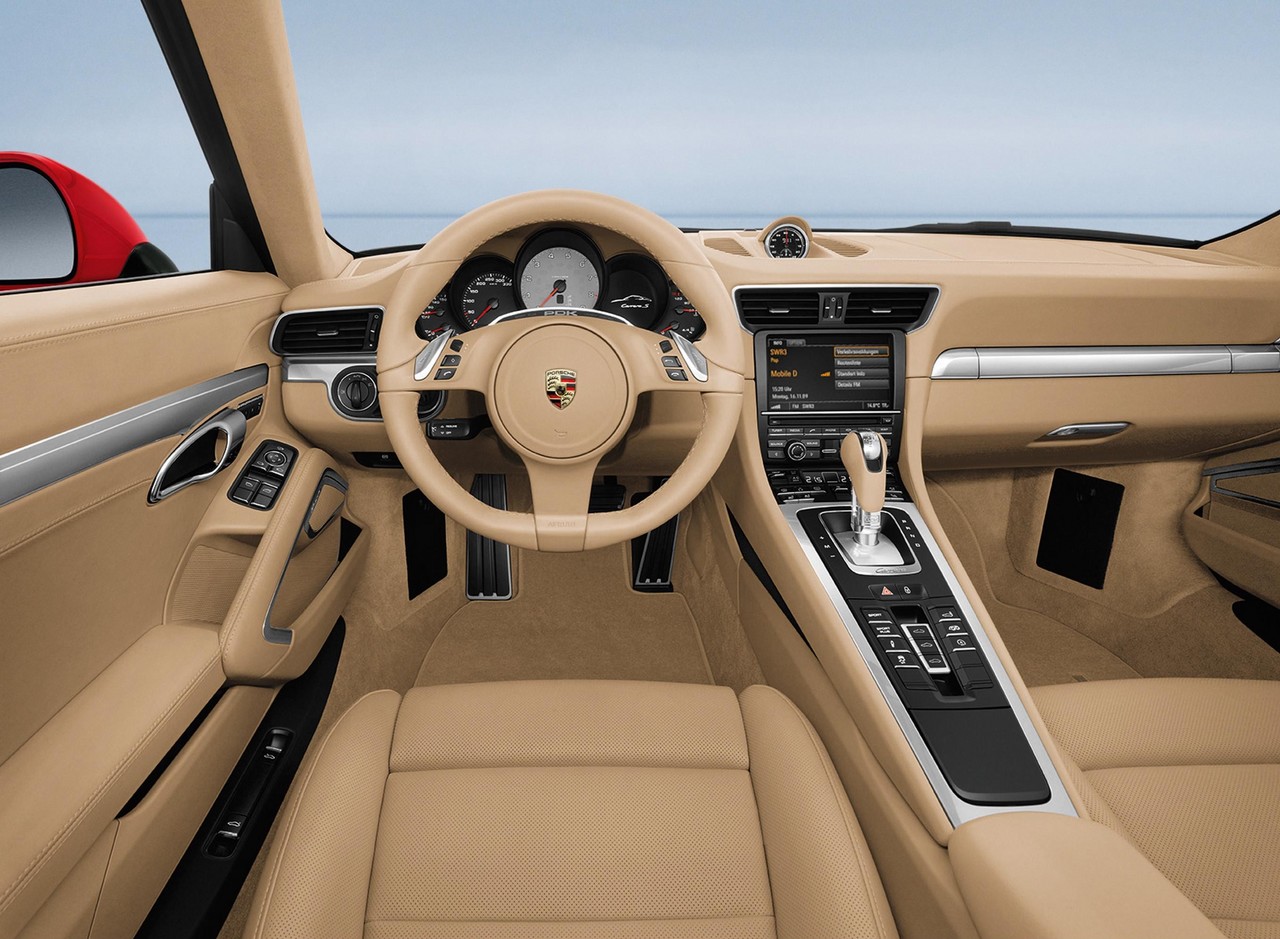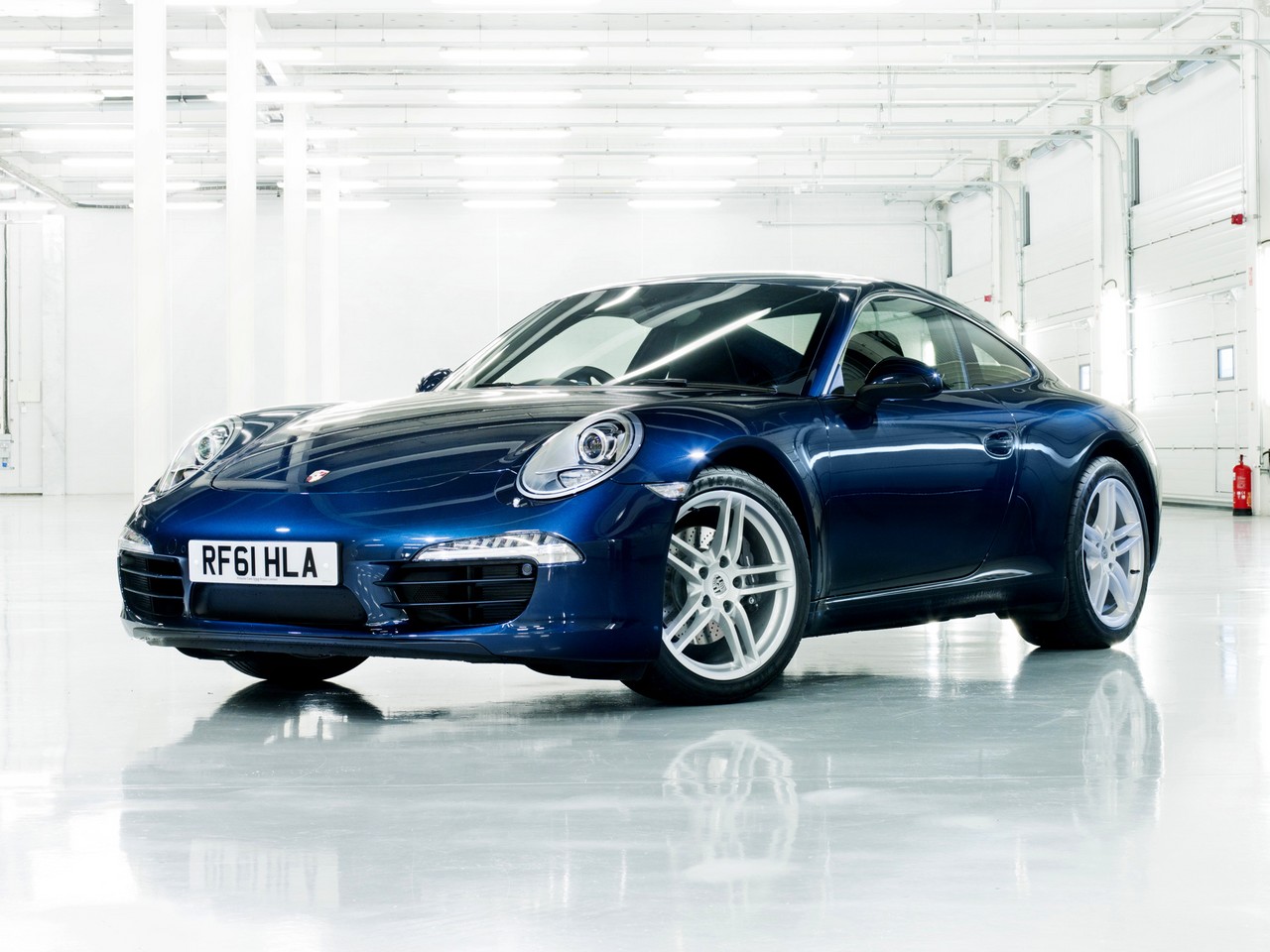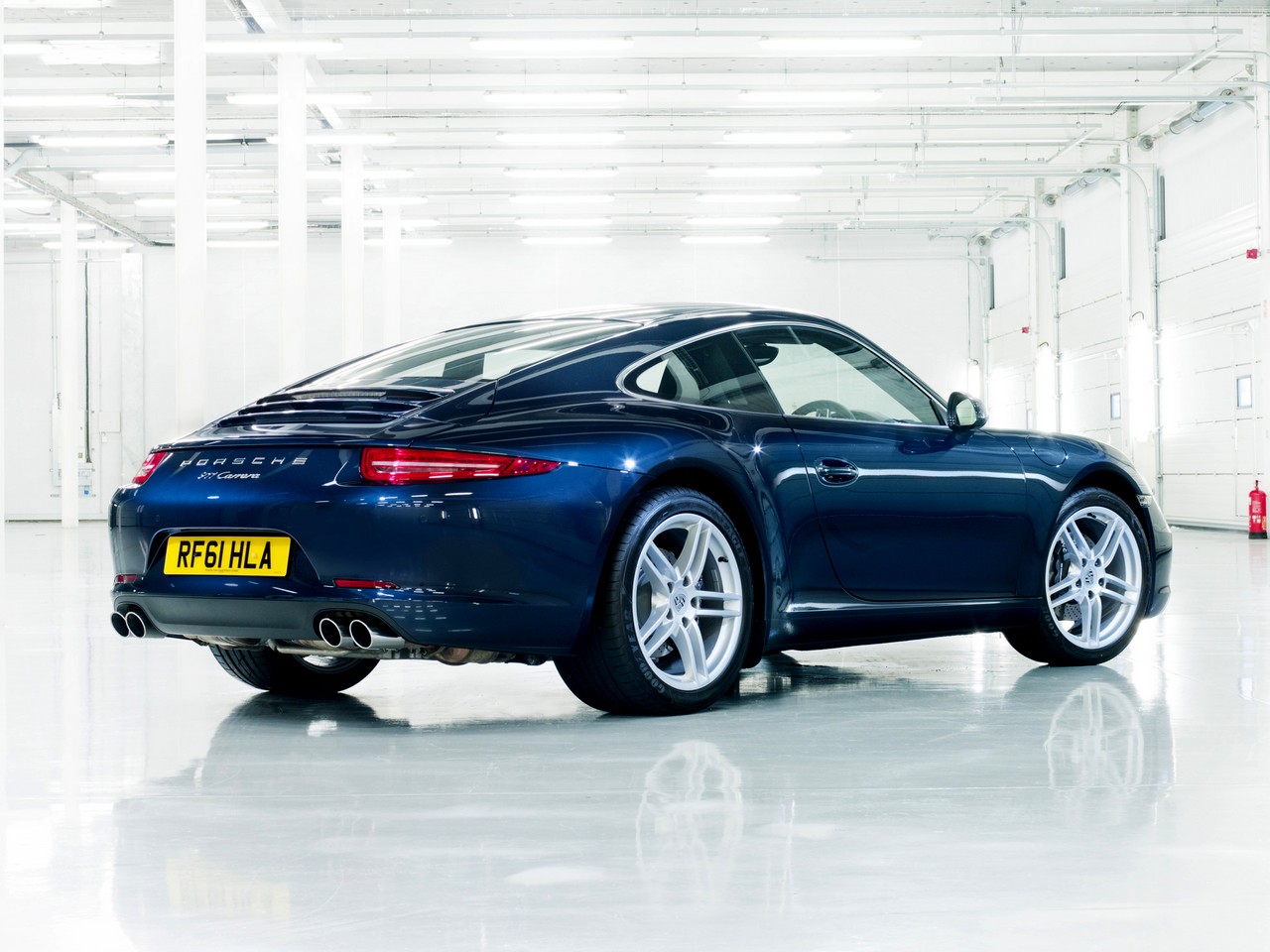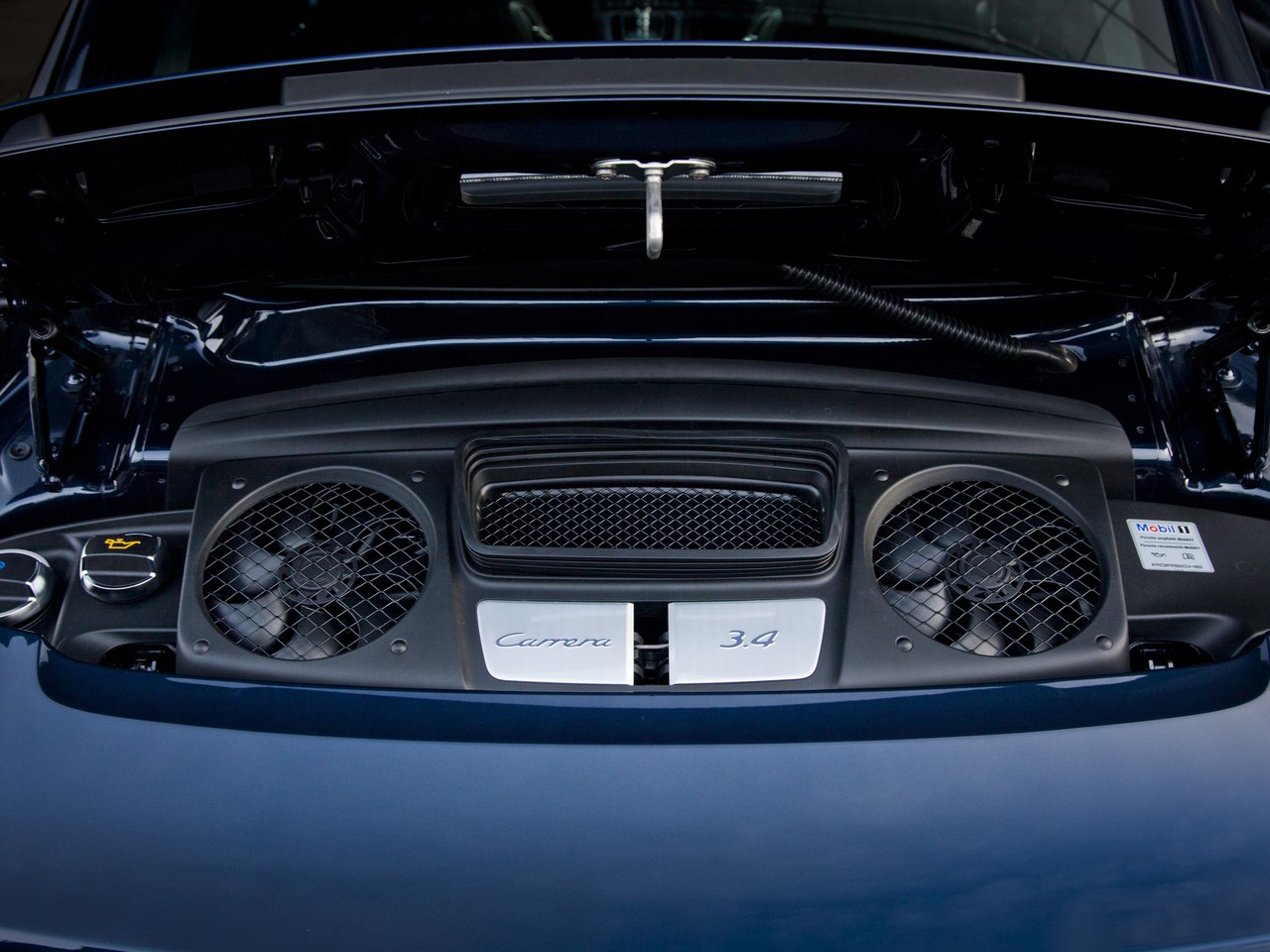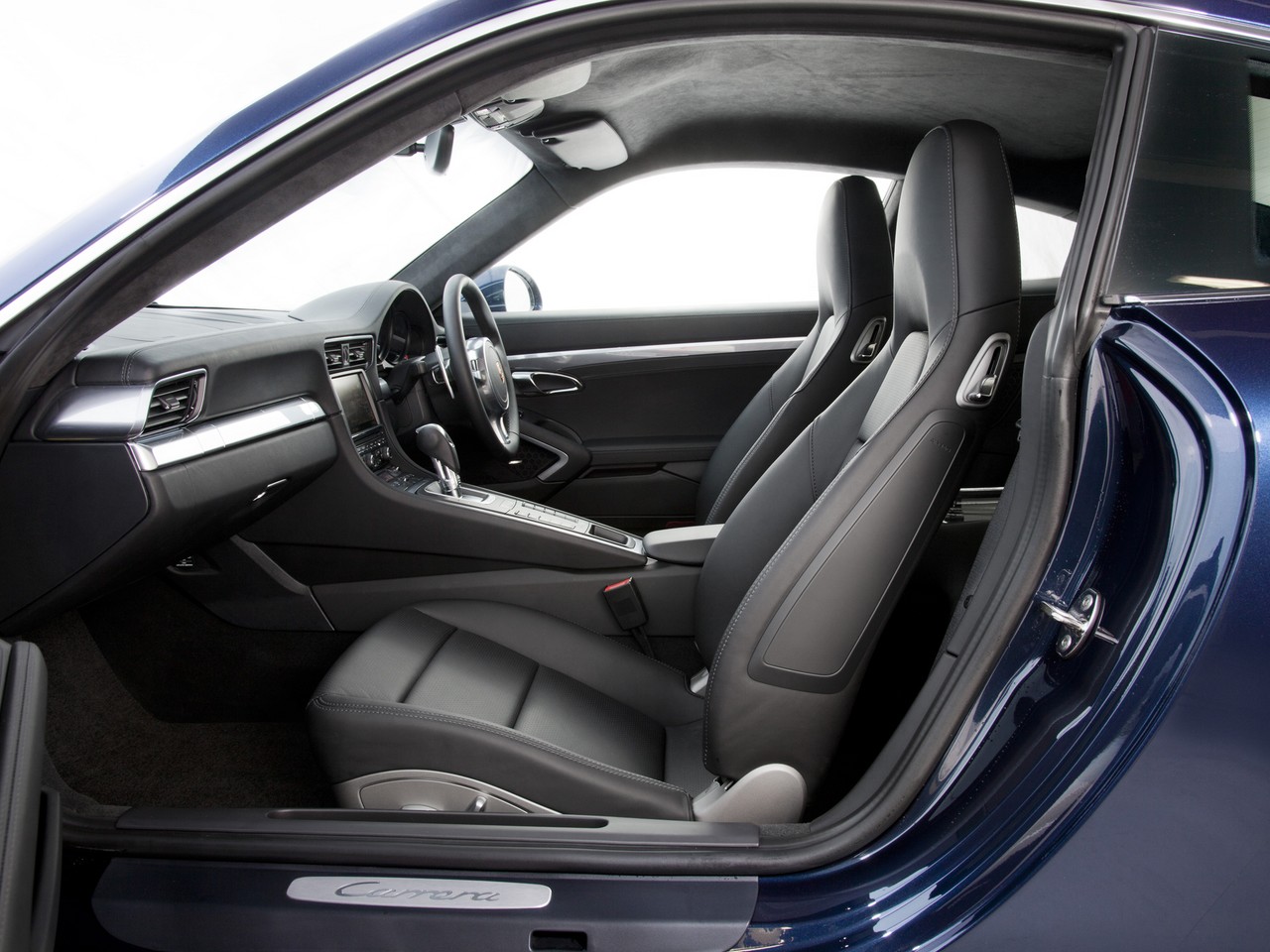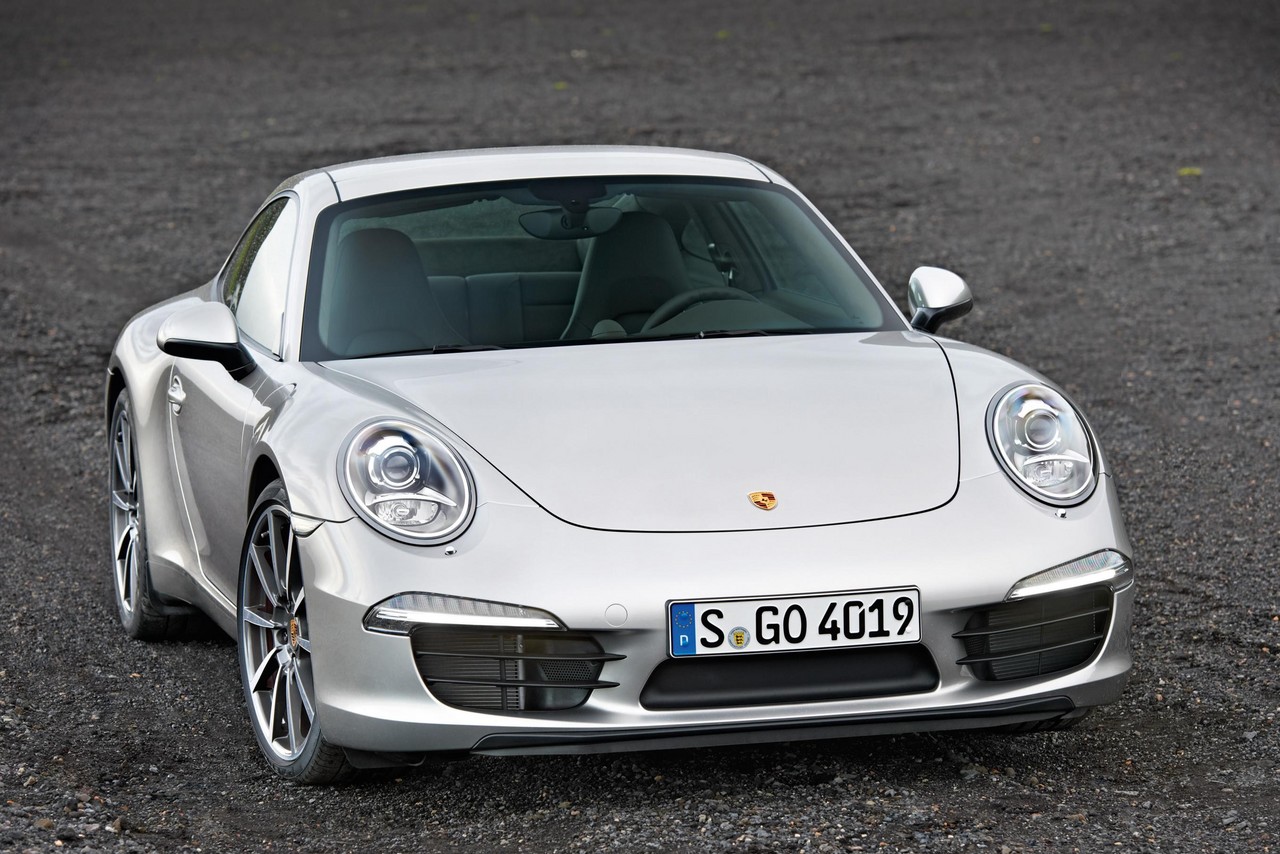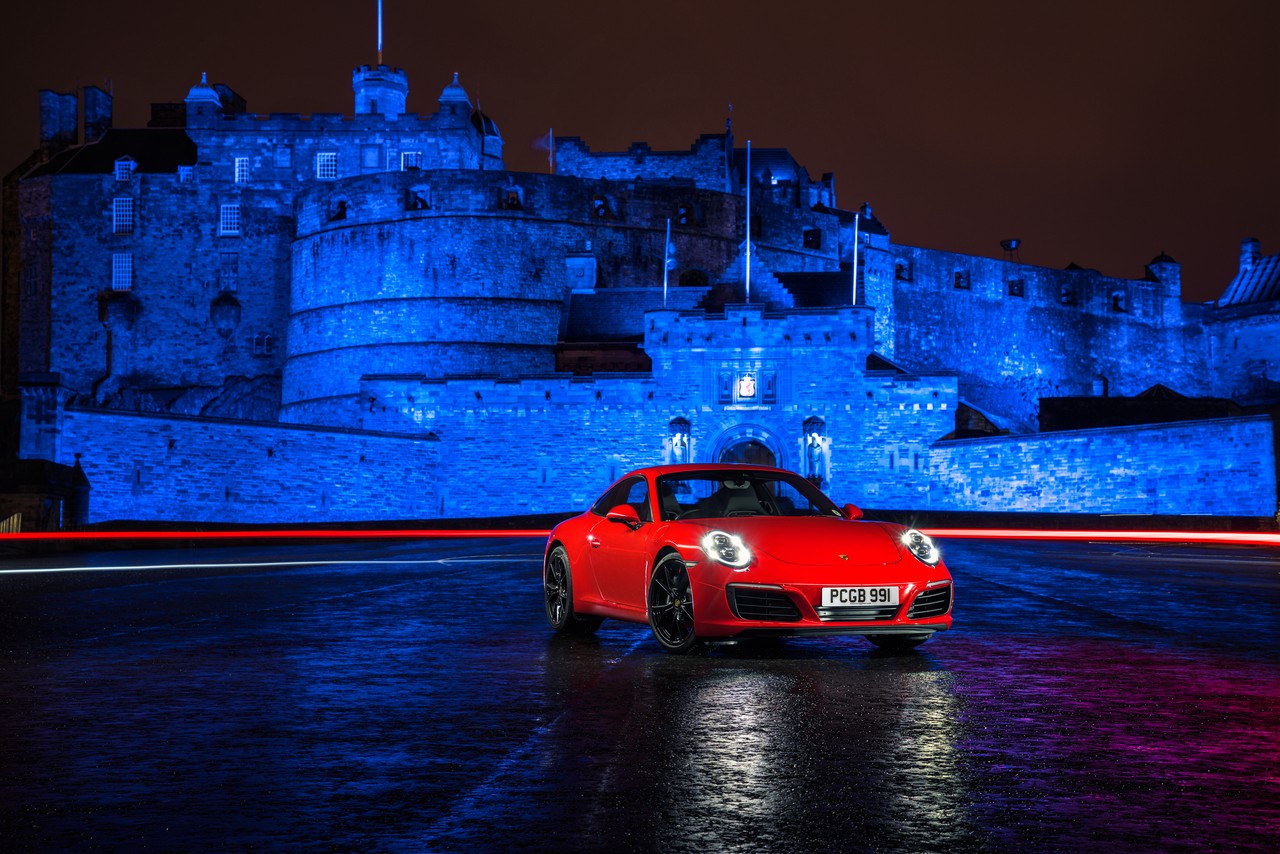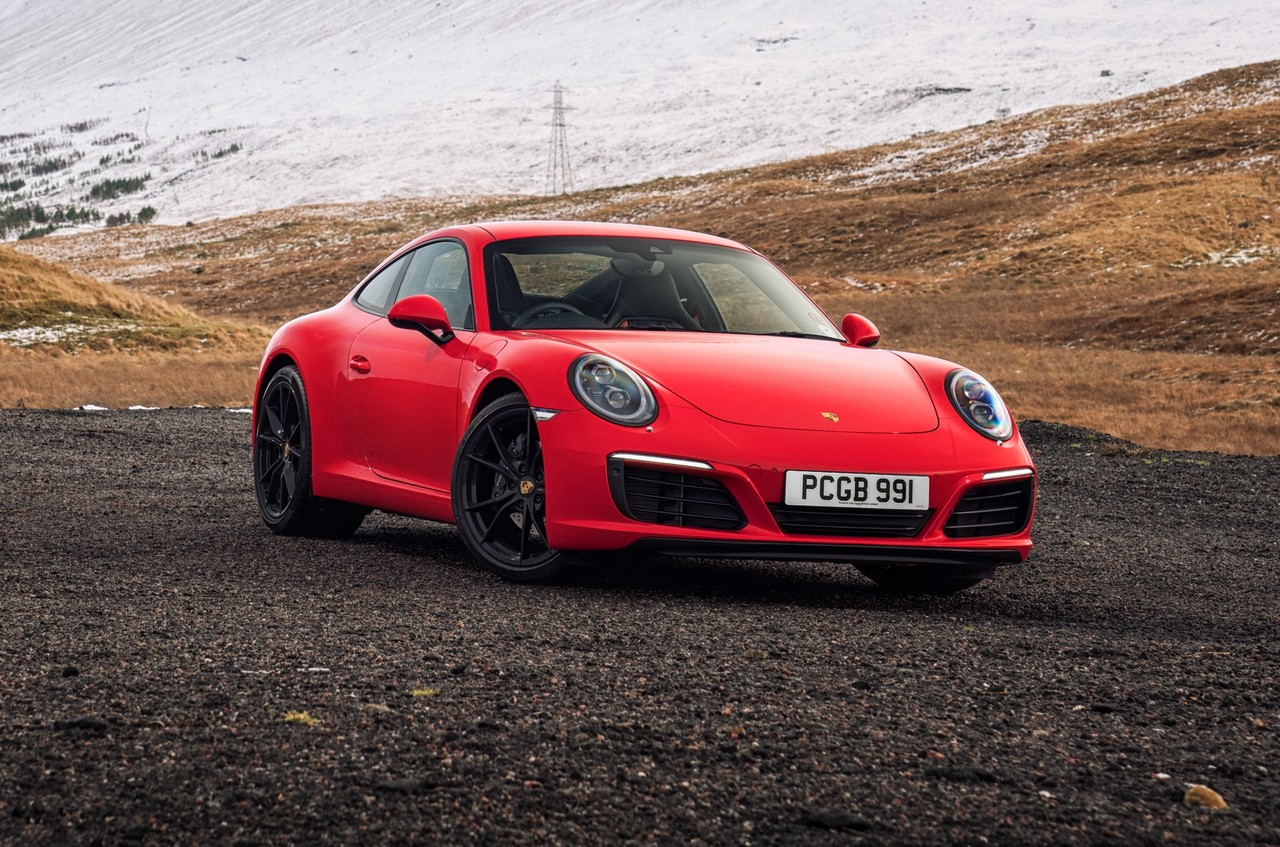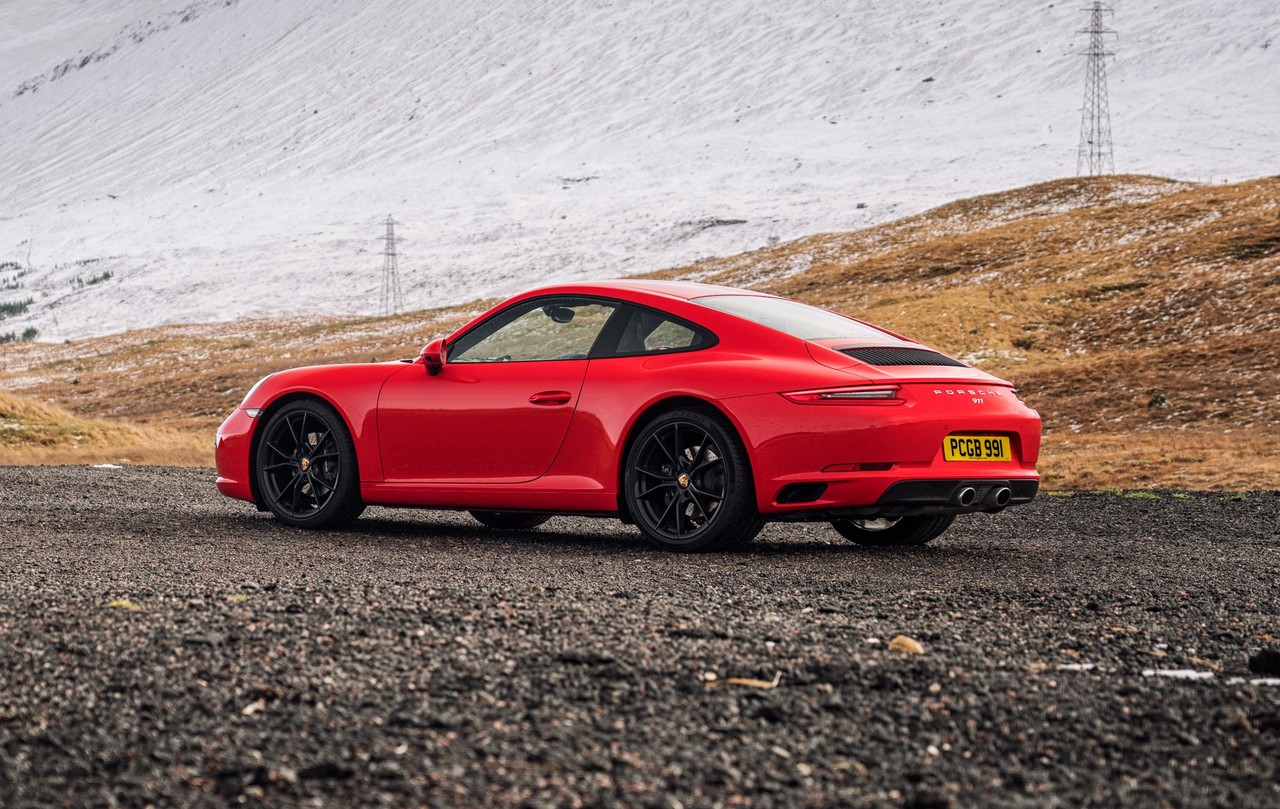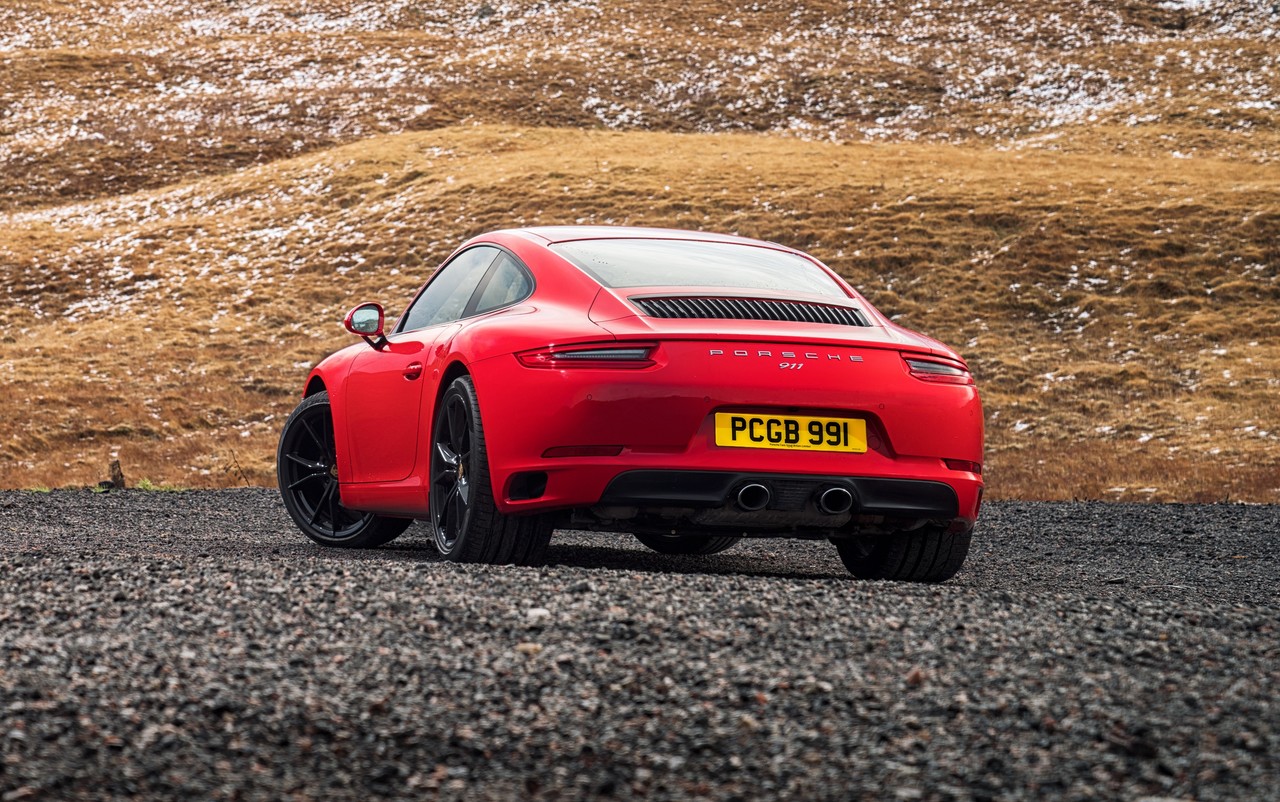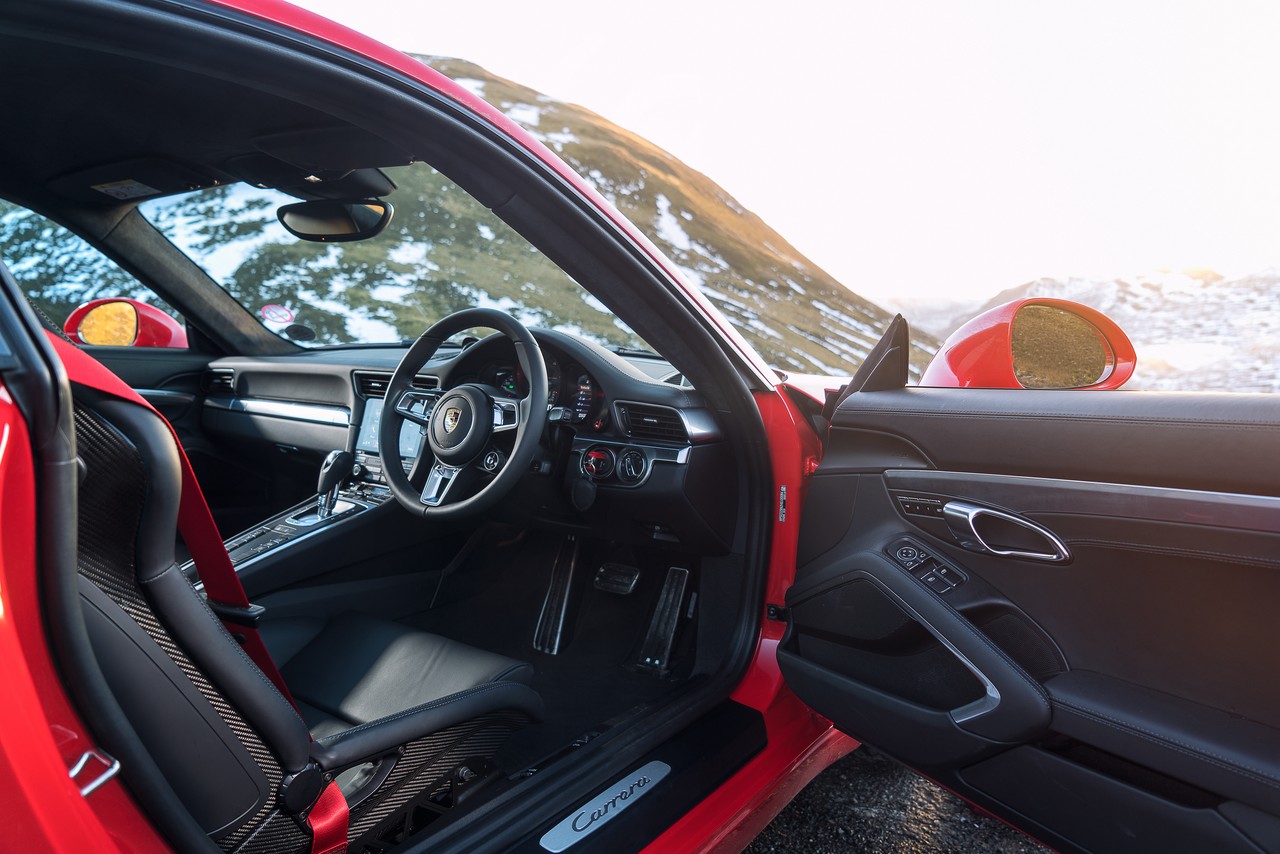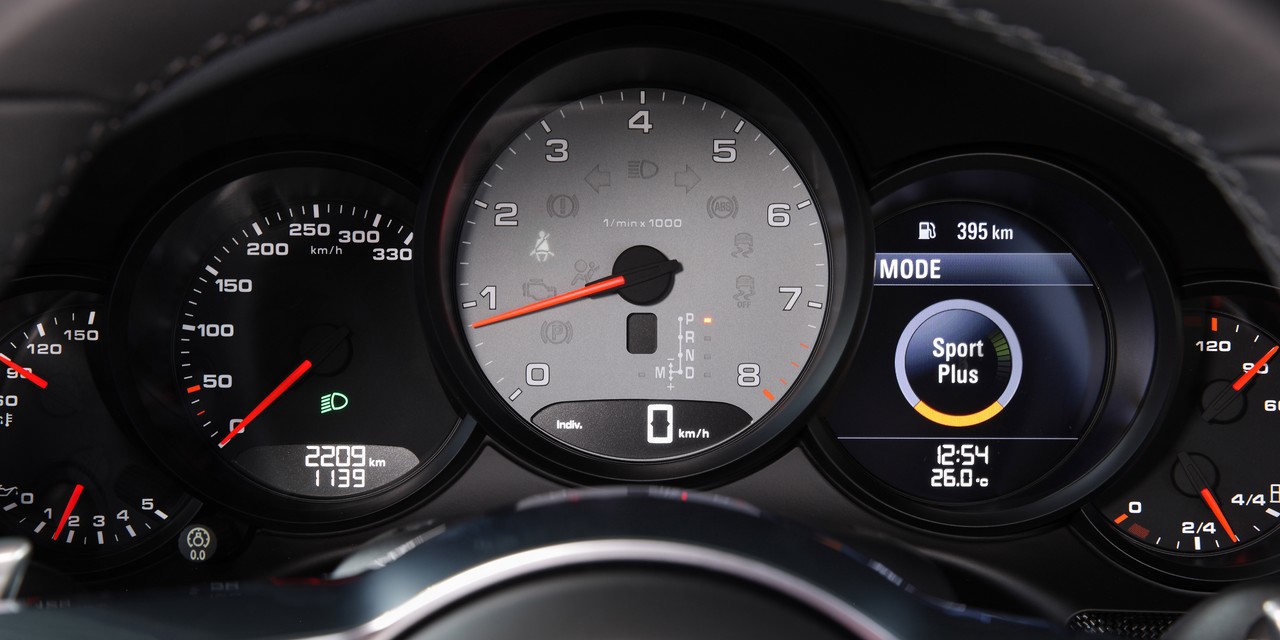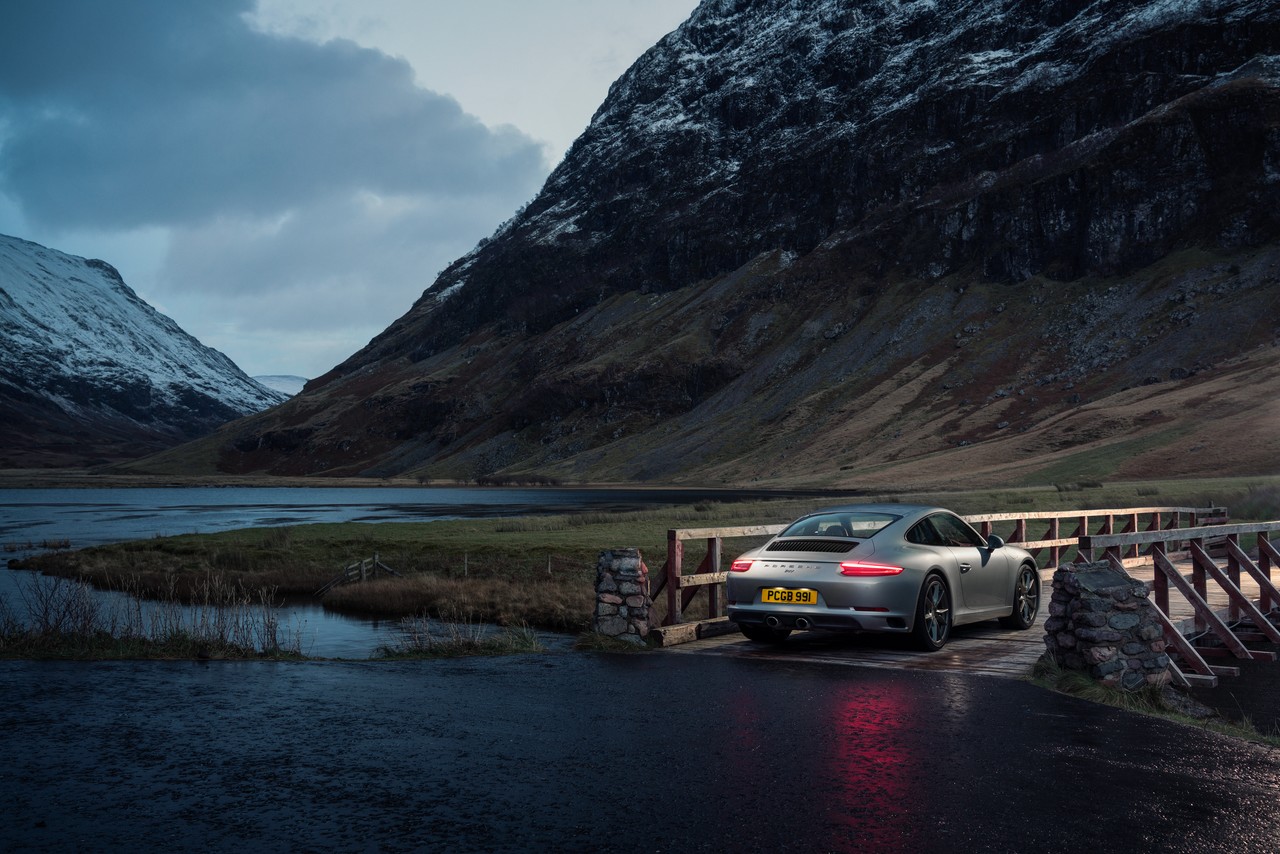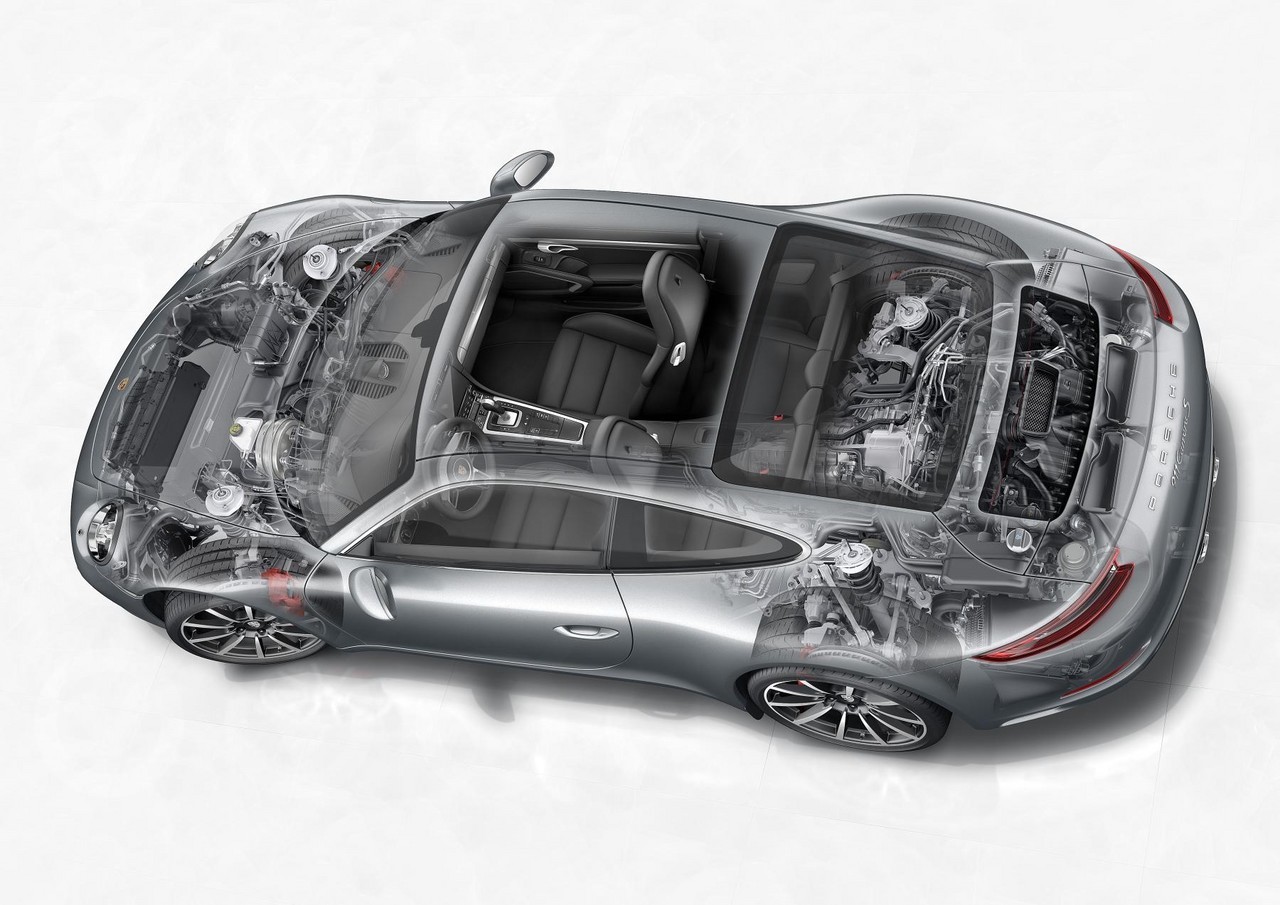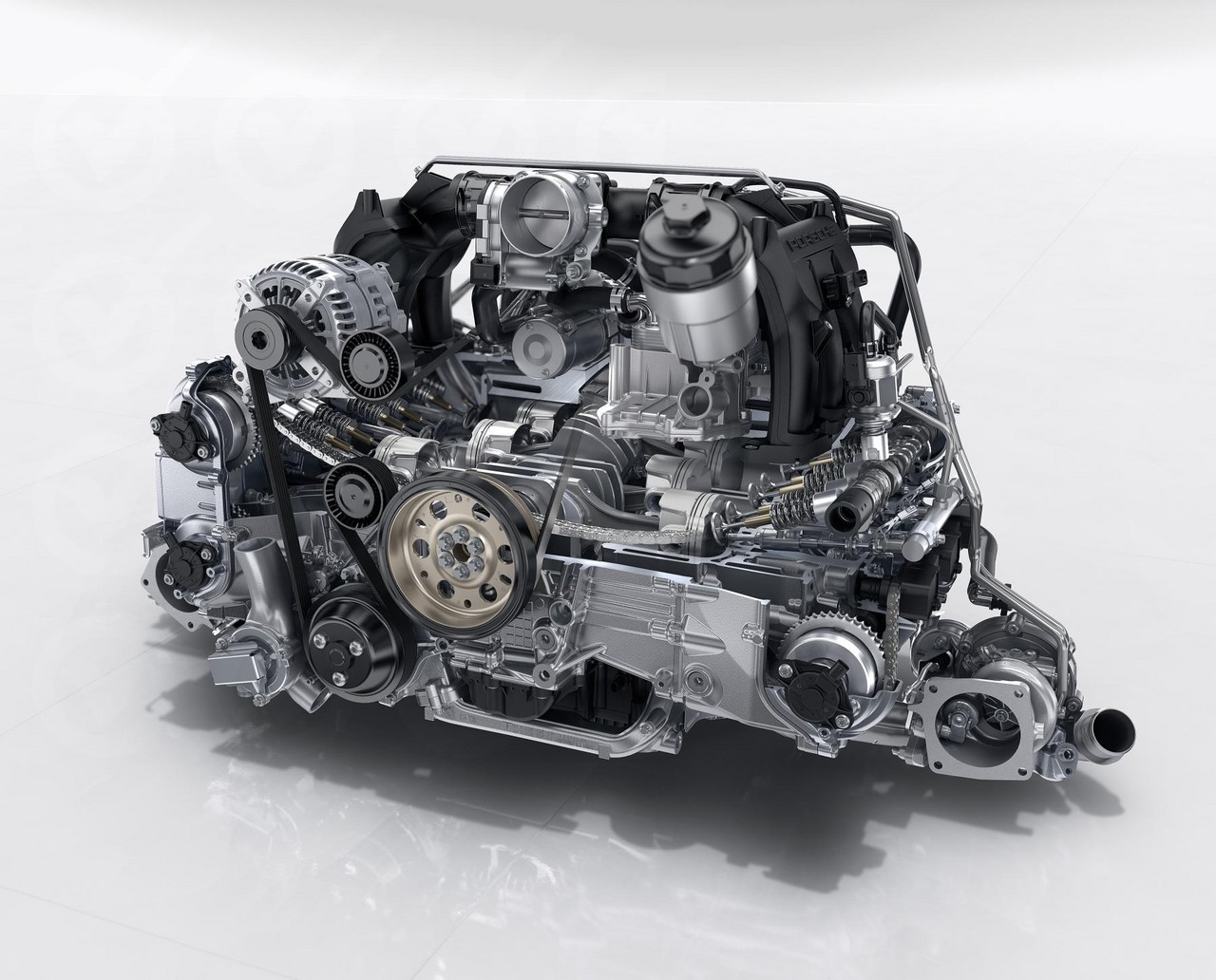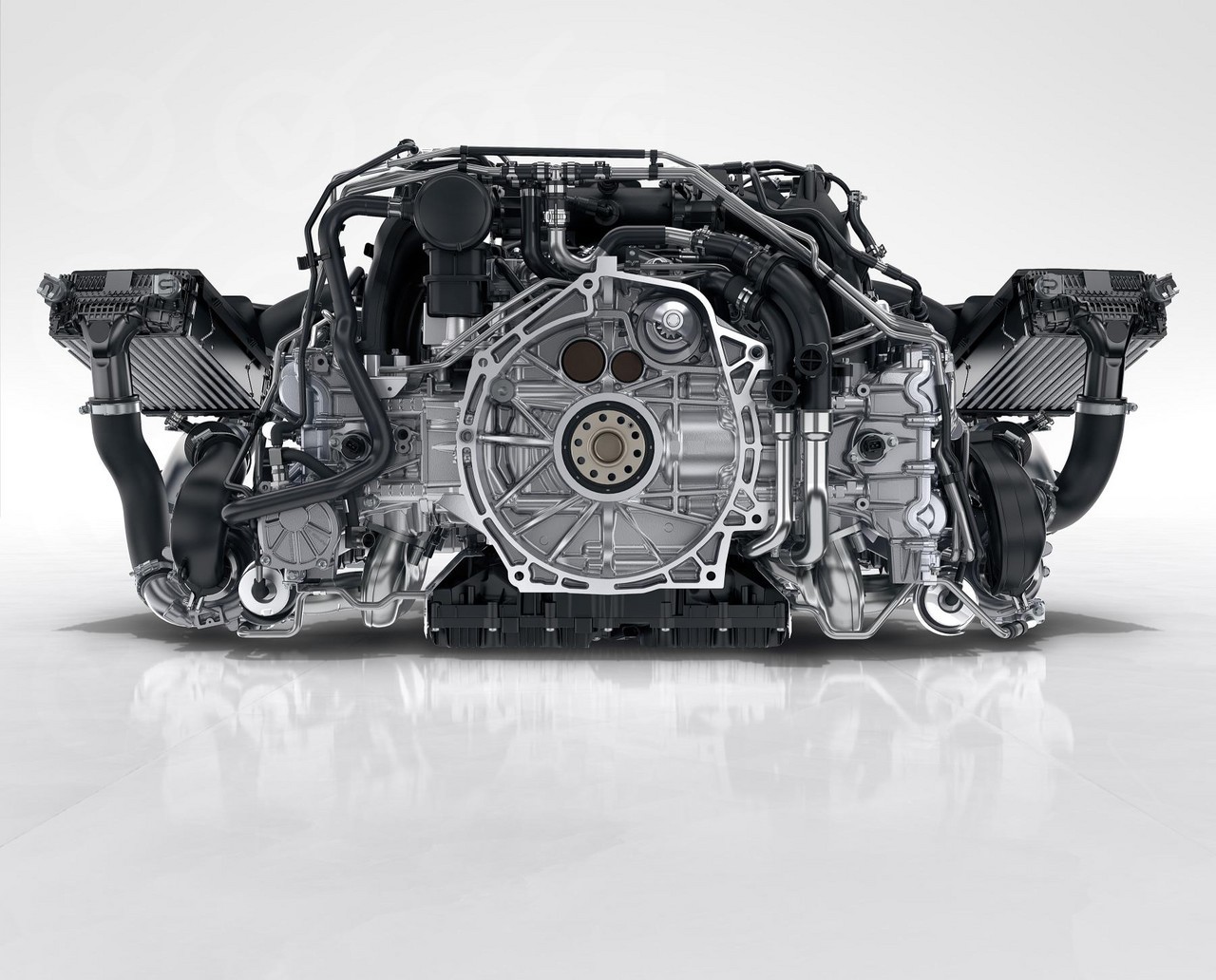
- Free-revving flat six-cylinder engines
- Supportive front seats
- High standard of interior fit and finish
- Excellent ride/handling balance
- Electromechanical steering is accurate and precise…
- … but lacks feel of Porsche 997 911 Coupe
- For seven-speed manual transmission, shift action lacks precision of six-speed predecessor
- Porsche 981 Cayman has superior dynamics
- High servicing and repair costs
Review: Porsche 991.I 911 Coupe (2012-15)
Overview
Released in March 2012, the Porsche 991 Series I (991.I) 911 Coupe range initially consisted of the rear-wheel drive Carrera and Carrera S variants. Manufactured in Stuttgart, the rear-wheel drive Porsche 911 Carrera and Carrera S were powered by 3.4- and 3.8-litre horizontally-opposed six cylinder engines respectively. The 911 Coupe range, however, was subsequently expanded with:
- The all-wheel drive 911 Carrera 4 and Carrera 4 S variants in March 2013;
- The 911 GT3, Turbo and Turbo S in December 2013; and,
- The 911 Carrera GTS in May 2014.
Engines
Of the engines,
- For the Carrera and Carrera S variants, the naturally aspirated 3.4- and 3.8-litre horizontally-opposed (or flat) six-cylinder engines had direct injection, double overhead camshafts, four valves per cylinder, Porsche’s VarioCam Plus variable intake valve timing system (with two-stage lift for intake valves controlled by electrohydraulically-operated tappets) and compression ratios of 12.5:1;
- For the GT3, its 3.8-litre engine differed in that it had a unique cylinder head, a six-hole direct injection system (operating at up to 200 bar), titanium connecting rods attached to forged aluminium pistons, hollowed valves, a new valve rocker arm control and a higher compression ratio of 12.9:1; and,
- For the Turbo and Turbo S, the 3.8-litre engines had twin variable geometry turbochargers and compression ratios of 9.8:1. For the Turbo S, maximum boost pressure was 1.2 bar (17.4 psi), though an overboost function could increase pressure to 1.35 bar (19.6 psi) for up to twenty seconds.
With the exception of the GT3, the engines had an ‘auto stop/start’ function which enabled them to automatically shut down when stationary in traffic – or cruising – to conserve fuel.
| Variant | Years | Drive | Engine | Trans. | Peak power | Peak torque |
|---|---|---|---|---|---|---|
| Carrera | 2012-15 | RWD | 3.4-litre MA104 petrol F6 |
7sp man., 7sp DCT |
257 kW at 7400 rpm | 390 Nm at 5600 rpm |
| Carrera 4 | 2013-15 | AWD | ||||
| Carrera S | 2012-15 | RWD | 3.8-litre MA103 petrol F6 |
7sp man., 7sp DCT |
294 kW at 7400 rpm | 440 Nm at 5600 rpm |
| Carrera 4 S | 2013-15 | AWD | ||||
| Carrera GTS | 2014-15 | RWD | 3.8-litre MA103S petrol F6 |
7sp man., 7sp DCT |
316 kW at 7500 rpm | 440 Nm at 5750 rpm |
| Carrera 4 GTS | 2014-15 | AWD | ||||
| Turbo | 2013-15 | AWD | 3.8-litre MA171 twin-turbo petrol F6 |
7sp DCT | 383 kW at 6000-6500 rpm | 660 Nm at 1950-5000 rpm |
| Turbo S | 2013-15 | AWD | 3.8-litre MA171S twin-turbo petrol F6 |
7sp DCT | 412 kW at 6500-6750 rpm | 700 Nm at 2100-4250 rpm (750 Nm with o/boost) |
| GT3 | 2013-15 | RWD | 3.8-litre MA175 petrol F6 |
7sp DCT | 350 kW at 8250 rpm | 450 Nm at 6250 rpm |
Transmissions
Transmission options consisted of a seven-speed manual or seven-speed double-clutch transmission (Porsche’s ‘PDK’ or Porsche-Doppelkupplungsgetriebe). For the Turbo and Turbo S, the seven primary driving gears in the PDF were supplemented with ‘virtual intermediate gears’ whereby two adjacent gears would be partially engaged simultaneously while slipping both clutches slightly for an effective gear ratio in-between them. This technique was used to reduce engine speed during constant speed cruising when the next higher gear would reduce engine speed by too much. Since the PDK employed dual wet clutches (oil-bathed), the virtual intermediate gear function resulted in no added wear according to Porsche.
All-wheel drive system
The Porsche 991 911 Carrera 4 and Turbo variants were fitted with an electronically controlled multi-plate clutch which enabled an infinitely variable front:rear torque split. In normal conditions, two-thirds of the engine’s torque was directed to the rear wheels. However, the Porsche Traction Management (PTM) system continuously monitored driving conditions (i.e. wheel rotation speeds, steering angle, longitudinal and lateral acceleration) and could send additional torque to the front wheels if required.
Dimensions and body
Compared to the Porsche 997 911 Coupe , the 991 911 Coupe was 64 mm longer (at 4491 mm), the same width (1808 mm), 7 mm lower (1303 mm) and had a 100 mm longer wheelbase (2450 mm). Relative to the standard 911, however,
- the 911 GT3 was 54 mm longer (at 4545 mm), 27 mm lower (1269 mm) and had a 7 mm longer wheelbase (2457 mm). For the GT3 chassis, height, toe and camber were all adjustable; and,
- the 911 Turbo and Turbo S were 15 mm longer (4506 mm) and 28 mm wider (1880 mm).
Despite its larger body, the 991 911 Coupe introduced a lightweight aluminium-steel chassis which reduced kerb weight by 45 kg yet contributed to a 25 per cent increase in torsional rigidity. Furthermore, the 911 Coupe had a drag coefficient of 0.29 Cd.
Steering and suspension
The Porsche 991 911 Coupe introduced electromechanical power steering (previously hydraulic) and revised MacPherson strut front suspension and multi-link rear suspension. Beyond this, however,
- The 911 Carrera S, Carrera 4 S, GTS, GT3, Turbo and Turbo S variants were equipped with ‘Porsche Active Suspension Management’ (PASM), an electronically-controlled variable damping system which provided continual adjustment of damper forces according to road conditions and driver behaviour;
- The 911 Turbo S and GT3 had Porsche Dynamic Chassis Control (PDCC) which consisted of active anti-roll bars that counteracted lateral acceleration when cornering to minimise body roll;
- The 911 Carrera S, Carrera 4 S, GTS, GT3, Turbo and Turbo S variants were fitted with Porsche Torque Vectoring (PTV) which provided targeted brake interventions at the inside rear wheel when cornering to reduce understeer, while the differential lock improved acceleration on exit. Models fitted with manual transmissions were fitted with a mechanically locking rear differential, while models with PDK transmissions had an electronically-controlled, fully variable differential lock (PTV Plus); and,
- The 911 GT3, Turbo and Turbo S had active rear wheel steering whereby electromechanical actuators on either side of the rear axle could vary the steering angle of the rear wheels by up to 2.8 degrees opposite the front axle’s steering angle, or up to 1.5 degrees in the same direction. At speeds below 50 km/h, the front and rear wheels could turn in opposing directions for increased turn-in. at speeds above 80 km/h, the wheels would turn in the same direction for greater stability.
Safety equipment
Standard safety equipment for the Porsche 991 911 Coupe included dual front airbags, front seat-mounted side airbags, front curtain airbags, ABS, electronic stability control, traction control and front seatbelts with pretensioners and load limiters.
Brakes
The Porsche 911 Carrera had 330 mm perforated and vented brake discs with four-piston aluminium monobloc brake calipers; the Carrera S, however, was fitted with 340 mm discs with six-piston front and four-piston rear calipers.
The 911 GT3, Turbo and Turbo S had 380 mm perforated and vented brake discs with six-piston front and four-piston rear aluminium monobloc calipers.
Features: 911 Carrera variants
Standard features for the 911 Carrera included 19-inch alloy wheels with 235/40 ZR19 front and 285/35 ZR19 rear tyres, a twelve speaker Bose surround sound system with a CD/DVD player, MP3-compatibility, auxiliary inputs (3.5 mm/USB) and Bluetooth connectivity, a satellite navigation system, dual-zone climate control air conditioning, fourteen-way power adjustable front seats with memory settings, leather trim, cruise control, bi-xenon headlights with washers, automatic headlights, rain-sensing wipers, rear parking sensors, a leather-wrapped multi-function steering wheel and gear lever, remote central locking, power windows and heated mirrors, a height and reach adjustable steering wheel, power-operated park brake, electrochromatic door mirrors, a trip computer, a motion-sensing alarm and an immobiliser.
The Carrera S variants were further equipped with 20-inch alloy wheels with 245/35 ZR20 front and 295/30 ZR20 rear tyres.
Features: 911 Turbo and Turbo S
Compared to the Carrera S, the 911 Turbo featured 20-inch front alloy wheels with 245/35 ZR20 front tyres and 295/30 ZR20 rear tyres, front parking sensors, proximity key (i.e. keyless entry), push-button start and tyre pressure monitoring. The 911 Turbo S was distinguished by its LED headlights and active seat bolsters.
Both the 911 Turbo and Turbo S had Porsche Active Aerodynamics (PAA) which consisted of a front spoiler that could be extended in multiple stages and a slotted rear wing that was adjustable for height and attack angle. As such, the driver could switch between different aerodynamic modes while preserving the balance of aerodynamic lift between the front and rear axles. When these aerodynamic elements were in their normal, retracted positions, the 911 Turbo had a drag coefficient of 0.31 Cd.
As part of its Sport Chrono package, the Turbo S had dynamic engine mounts which contained magnetorheological fluid. When aggressive driving was detected, an electric current would be applied to the fluid to increase its viscosity and thereby stiffen the engine mounts.
Features: 911 Carrera GTS
Compared to 911 Carrera S, the 911 Carrera GTS had 10 mm lower suspension and featured Alcantara trim for the centre seat panels, steering wheel rim and door storage trim. Like the 911 Turbo S, the 911 Carrera GTS was also fitted with Porsche’s ‘Sport Chrono’ package.
Visually, the 911 Carrera GTS could be identified by its ‘silky matt black’ 20-inch Turbo S design wheels with central locks, Aerokit front apron, smoked headlights, SportDesign exterior mirrors, black ventilation screen for the rear lid and sport exhaust system with black chrome tailpipes. Furthermore, the rear-wheel drive 911 Carrera GTS was also fitted with the wider all-wheel drive body.
Porsche 991 911 GT3
As a racetrack-oriented vehicle, the GT3 omitted many of the features of the 911 Carrera such as its sound and satellite navigation systems, but was fitted with LED headlights. Nonetheless, the 911 GT3 had
- 20-inch forged aluminium wheels with 245/35 ZR20 front and 305/30 ZR20 rear tyres;
- A variable exhaust which, when activated, reduced back pressure to improve gas exchange and increased torque from 3000-4000 rpm by up to 35 Nm;
- A fixed rear wing; and,
- Dynamic engine mounts.
The 911 GT3 could accelerate from rest to 100 km/h in 3.5 seconds and had a top speed of 315 km/h.
2015 Porsche 911 Coupe Black Edition
Produced from May 2015, the 911 Coupe Black Edition was distinguished from the Carrera variants by its 20-inch alloy wheels (as per the 911 Turbo), LED headlights with the ‘Porsche Dynamic Light System Plus’ (PDLS+), full leather interior with embossed Porsche crests on the front headrests, rear view camera and ‘Park Assist’ with front and rear parking sensors. Visually, the 911 Coupe Black Edition could be identified by its black paint finish and the ‘Black Edition’ logos on its door guards.
Brochures
- Brochure: Porsche 991 911 Coupe and Cabriolet (November 2013)
- Brochure: Porsche 991 911 Turbo (December 2013)
- Brochure: Porsche 991 911 Coupe 50th Anniversary Edition (April 2013)
Review: Porsche 991.II 911 Coupe (2015-18)
Overview
Commencing production in late 2015, the Porsche 991 Series II (991.II) 911 Coupe introduced new 3.0-litre biturbo horizontally-opposed six-cylinder engines for the Carrera and Carrera S models, while more powerful engines were introduced for the 911 Turbo and Turbo S. Other changes included updated styling, the Porsche Communication Management system, revised suspension and rear axle steering.
The Porsche 991.II 911 Carrera GTS and Carrera GTS 4 were available to order in Australia from January 2017, with the 911 GT3 following in March 2017.
911 Turbo and Turbo S engines
For the 911 Turbo, the inlet ports were modified, new injection nozzles were introduced and fuel pressure was increased; the 911 Turbo S also had new turbochargers with larger compressors. The engines also introduced a ‘dynamic boost’ function which maintained charge pressure during load changes – such as when the accelerator pedal was briefly released – by interrupting fuel injection and maintaining the position of the throttle valve.
For Australia, the 911 Turbo and Turbo S were fitted with Porsche’s Sport Chrono Package as standard which enabled the driver to select from Normal, Sport, Sport Plus and Individual drive modes. Further, a new ‘Sport Response’ button prepared the engine and gearbox for maximum response – for a duration of 20 seconds – at the push of a button. The 911 Turbo and Turbo S could accelerate from rest to 100 km/h in 3.0 and 2.9 seconds, respectively.
| Variant | Engine | Trans. | Peak power | Peak torque |
|---|---|---|---|---|
| Carrera, Carrera 4 |
3.0-litre DCK biturbo petrol F6 |
7sp man., 7sp DCT |
272 kW at 6500 rpm | 450 Nm at 1700-5000 rpm |
| Carrera S, Carrera 4 S |
3.0-litre DCH biturbo petrol F6 |
7sp man., 7sp DCT |
309 kW at 6500 rpm | 500 Nm at 1700-5000 rpm |
| Carrera GTS, Carrera 4 GTS |
3.0-litre biturbo petrol F6 | 7sp man., 7sp PDK |
331 kW at 6500 rpm | 550 Nm at 2150-5000 rpm |
| Turbo | 3.8-litre DAB biturbo petrol F6 |
7sp DCT | 397 kW at 6400 rpm | 660 Nm at 1950-5000 rpm (710 Nm with Sport Chrono Package) |
| Turbo S | 3.8-litre DBC biturbo petrol F6 |
7sp DCT | 427 kW at 6750 rpm | 700 Nm at 2100-4250 rpm (750 Nm with Sport Chrono Package) |
| GT3 | 4.0-litre petrol F6 | 6sp man., 7sp DCT |
368 kW at 8250 rpm | 460 Nm at 6000 rpm |
Styling and wheels
The Porsche 991.II 911 Coupe could be identified by its new headlights with four-point daytime running lights, inset door handles, redesigned engine cover with vertical louvres and four-point brake lights. The 991.II 911 Turbo and Turbo S could be identified by their new front end with side airblades, twin LED front light strips and additional blade in the central air intake.
The 991.II 911 Carrera was fitted with new five slim twin spoke alloy wheels and reduced rolling resistance tyres. For the 911 Carrera, the width of the rear rims increased by 0.5 inches to 11.5 inches, while the Carrera S had 305 mm rear tyres (previously 295 mm). To match the Turbo S, the 991.II Turbo was fitted with 9.0J x 20 front and 11.5J x 20 rear wheels.
Interior
Inside, the 991.II 911 Coupe featured ‘Porsche Communication Management’ (PCM) with a seven-inch touch display and voice control. Furthermore, PCM could be operated using multi-touch gestures like a smartphone and could interpret hand-written user inputs; the centre armrest also had an integrated smartphone tray for battery charging and optimised mobile phone reception. For Australian-delivered models, however, mobile phones and smartphones could only be connected via Bluetooth (or USB); as such, Google Earth and Google Streetview navigation functions were delayed until later in 2017 when a new LTE module was certified for Australia.
The 991.II 911 Carrera had a new steering wheel design – based on that used in the 918 Spyder – which had a diameter of 375 mm; the optional ‘GT sports’ steering wheel, however, will had a 360 mm diameter.
PASM, rear axle steering and hydraulic lift
As standard, the 991.II Carrera and Carrera S were fitted with an updated Porsche Active Suspension Management (PASM) system which included electronically-controlled dampers and could lower the ride height by 10 mm. The 911 Carrera was also fitted with new shock absorbers which had wider spread characteristics that, according to Porsche, enhanced comfort due to a ‘more precise response characteristic’ and ‘improve body connection during dynamic driving’
As extra-cost options, the 911 Carrera was available with:
- A rear axle steering system which was adapted from the 911 Turbo and 911 GT3. According to Porsche, rear-axle steering enhanced turn-in behaviour, reduced the turning circle by 0.5 metres and improved stability when changing lanes at high speeds; and,
- A hydraulic lift system which consisted of integrated lifting cylinders in the struts of the front axle. When activated by a button, the system increased ground clearance at the front axle by 40 mm within five seconds.
Safety equipment
As standard, the 991.II 911 Coupe was fitted with a post-collision braking system which applies the brakes after a collision to reduce vehicle speed and the likelihood of a secondary collision.
Available as an option, the ‘lane change assistant’ used a radar to monitor traffic behind the driver and could warn the driver of approaching traffic via LEDs in the left and right of the door mirrors.
Features
For Australia, standard features for the Porsche 991.II 911 were extended to include digital radio tuning (DAB+) and Porsche’s ‘Front Park Assist’ which included reversing camera.
For 911 Carreras with the PDK, the Adaptive Cruise Control (ACC) system had a coasting function which disengaged the clutch to reduce fuel consumption when coasting.
Features: Porsche 911 Carrera GTS
The Porsche 911 Carrera GTS could be identified by its 20-inch wheels painted in silk-gloss black, all-wheel drive body (even for rear-wheel drive models), ‘Sport Design’ front apron with low front spoiler, ‘Sport Design’ door mirrors, increased rear spoiler extension, smoked tail lights, ‘silk-gloss black’ air intake grille and central black twin tailpipes. For rear-wheel drive models, the Carrera GTS had a black trim strip between the tail lights; the Carrera 4 GTS, however, had a light strip.
Inside, the 911 Carrera GTS had ‘Sports seats Plus’ with GTS logos, brushed black anodised aluminium trim strips on the instrument cluster and Alcantara trim for the seats, steering wheel rim, centre console and armrests. As standard, the 911 Carrera GTS was also fitted with Porsche’s ‘Sport Chrono Package’ with selectable drive modes.
March 2017 update: Porsche Connect Plus and 911 S power kit
From March 2017, the Porsche 991 911 Coupe was equipped with the Porsche Connect Plus infotainment system. Porsche Connect Plus included Apple CarPlay smartphone integration, an LTE telephone module with SIM card reader, Wi-Fi hotspot functionality and the Porsche Connect App which provided specific smartphone content via the integrated Porsche Communication Management (PCM) system in the centre console. Furthermore, the Porsche Connect App included the following features: My Calendar, My Destinations, Contacts, Picture Navigation (navigation to GPS co-ordinates in picture) and First Mile/Last Mile navigation which provided navigation from the vehicle to the final destination when on foot.
From March 2017, the 911 Carrera S and 911 Carrera 4S could be specified with an optional power kit which increased peak power by 22 kW to 331 kW. The power package upgrade included larger turbochargers, the Sport Chrono package with dynamic engine mounts, a modified brake cooling system and a twin exhaust system. Depending on vehicle specification, prices for the power kit started at $24,580. From June 2017, the power kit was available from Porsche Tequipment as a retrofit option for 911 S models that had been fitted with the Sport Chrono package.
2017 Porsche 991.II 911 GT3
Revealed at the Geneva Motor Show in March 2017, the Porsche 991.II 911 GT3 is powered by a 4.0-litre horizontally-opposed six-cylinder engine. Furthermore, the 991.II 911 GT3 can accelerate from rest to 100 km/h in 3.4 or 3.9 seconds with its PDK and manual transmissions, respectively.
The 991.II 911 GT3 features aerodynamic enhancements for the front mask, front spoiler, rear exhaust and new diffusor. Furthermore, the 911 GT3 will be fitted with the Porsche Track Precision app as standard, enabling drivers to display, record and analyse detailed driving data on their smartphone. For further information, please see the 2017 Porsche 911 GT3 catalogue .
For Australia, the Porsche 991.II 911 GT3 has a list price of $327,100 (excluding on-road costs such as stamp duty, registration and, where required, CTP insurance); deliveries are expected to commence in the fourth quarter of 2017.
Related links
- Porsche Cars Australia: Porsche 911 Coupe
- Catalogue: Porsche 991.II 911 GT3 (March 2017)
- Wikipedia.org: Porsche 991 911
